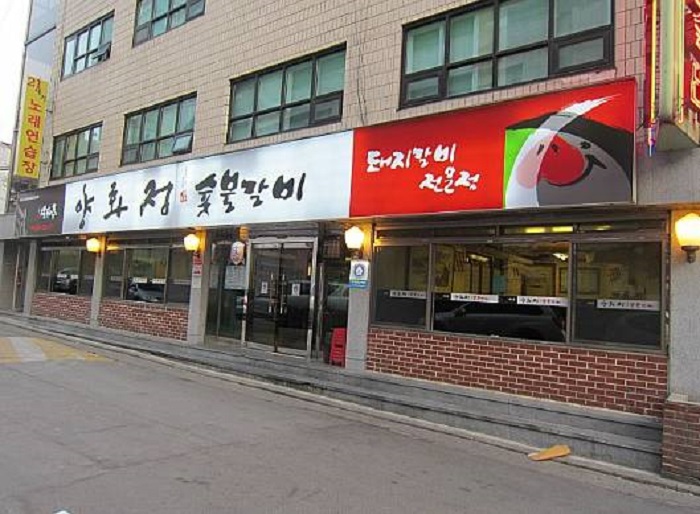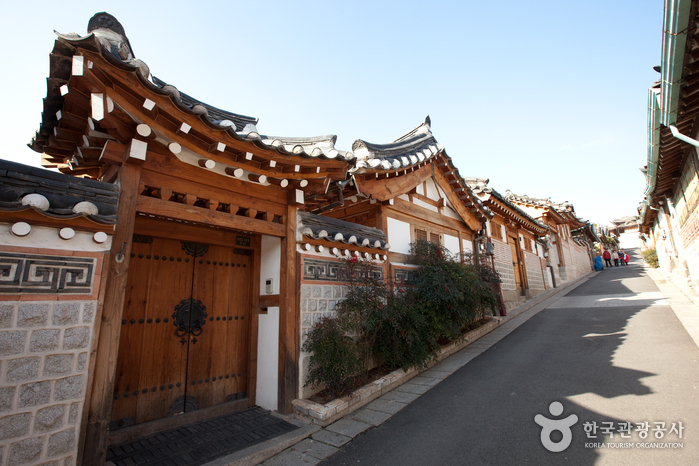Parc de l'indépendance Seodaemun (서대문독립공원)
6.8Km 2022-12-15
251, Tongil-ro, Seodaemun-gu, Seoul
+82-2-3140-8305
Le parc de l'indépendance fut un lieu de détention de nombreux prisonniers politiques en Corée durant les mouvements d'indépendance pour le pays jusqu'au 15 août 1945 mais aussi durant les bouleversements politiques en Corée jusque dans les années 1960. Les sept zone de détention, la zone des exécutions, et la prison pour femme au sous-sol ont été entièrement restaurés après le transfert du centre de détention de Séoul dans la ville de Uiwang. Au sein du parc Tapgol, une sculpture commémorative a été installée en commémoration du soulèvement du 1er mars. La porte Yeongeunmun a été intégré au parc le 15 août 1992.
Seochon Guest House [Korea Quality] / 서촌 게스트하우스 [한국관광 품질인증]
6.8Km 2023-04-07
28-3, Jahamun-ro 7-gil, Jongno-gu, Seoul
+82-010-3345-9680
Seochon Guest House is located in Seochon, which is becoming a hot place for tourists in Seoul, and precisely on the road to Suseong Valley, whichis filled with interesting stores and is also well-known for Park Nosoo Art Gallery and the House of Yun Dong-ju (poet). Seochon Guest House is nicknamed ‘Jaeminangol (interesting village)’ after Baekseok’s poem ‘Yeowunangol’, with the aim of providing a visit full of interesting experiences. Passing through a garden and entering the main building, the unique charm of this hanok building, the staircase to get to the first floor from daecheong (main floored room), catches the eye of the visitors. In addition, the building is decorated with various stylish objects including paintings and Korean musical instruments. The terrace situated on the first floor offers an open view of the surrounding area including roof tiles of hanok structures and alleyways in Seochon. It is said that Korean novelist Yoon Hu-myeong also appreciated the structure of the guesthouse, saying, “It is an interesting place.” Built in the 1930s, the house, which has many storage places, was taken by the owner couple in spring 2014 as they were attracted by the house during their trip to Seochon. After the repair work, the ground floor of the house was opened for guests from January 2016, hoping that guests could share their daily experiences and stories with each other. The guestrooms and the main floored room on the ground floor are open to guests, with the exception of the first floor, which is used by the owner couple. The living room is equipped with books, a curved TV, and a table. The tasty meal, which is served in the kitchen, consists of rice and soup with six side dishes and is much loved by guests. The guesthouse offers a total of four rooms – Jae Room, which is the most Korean-style room; Mi Room, which has a combined style of a Korean-style room and Western-style room; Nan Room, which is an ideal room for meditation with a beautiful paper window; and Ahn Room, which is equipped with a veranda and a pretty flowerbed. Every room has its separate charm with various comfortable bedding to provide a quiet and cozy bedroom for guests in the middle of the city. Furthermore, the guesthouse holds a pansori (epic chant) performance twice a year. The owner started learning how to sing pansori to promote the Korean culture and tradition to foreigners. When a pansori performance is held, the owner offers traditional Korean snacks and drinks including sikhye (sweet rice punch), sujeonggwa (cinnamon punch), traditional sweets and cookies, and tteok (rice cakes) to visitors, tourists, and performers. Moreover, it provides cultural programs such as a Gukak (Korean classical music) experience, Korean traditional clothes experience, and making Korean food experience, as well as other activities with guests, such as trip to the city wall between Inwangsan Mountain and Bugaksan Mountain, and the Royal Palace Tour to Gyeongbokgung Palace, etc., as well as a trip to a traditional market.
Yanghwajeong (양화정)
6.8Km 2021-03-29
17, World Cup-ro 1-gil, Mapo-gu, Seoul
+82-2-323-5777
It is a 30-year-old pork rib specialty store. This Korean dishes restaurant is located in Mapo-gu, Seoul. The representative menu is marinated grilled ribs.
Les huit paysages du village Bukchon (북촌 8경)
6.8Km 2024-12-13
37, Gyedong-gil, Jongno-gu, Seoul
+82-2-2148-4161
Bukchon qui signifie "village du nord", est nommé ainsi car il se trouve au nord de Cheonggyecheon et de Jongno. Le quartier situé au sud de Jongno, autrement dit les environs du mont Namsan, était appelé "Namchon (village du sud)". Au cours de la dynastie Joseon, la famille royale et les aristocrates habitaient à Bukchon alors que les fonctionnaires résidaient traditionnellement à Namchon. Aujourd'hui, le village hanok, situé entre le palais Gyeongbokgung et le palais Changdeokgung, est appelé Bukchon. En parcourant les nombreuses petites ruelles dans ce quartier traditionnel, vous pouvez trouver les "huit paysages du village Bukchon". Chacun de ces lieux comportent des spots photos spécifiques. Vous pouvez y prendre de belles photos en appréciant les paysages du quartier et la beauté des hanok.
[Les huit paysages du village Bukchon]
* Premier paysage du village Bukchon - La vue sur le palais Changdeokgung
Le premier spot photo offre la meilleure vue sur le palais Changdeokgung. Prenez la rue Chandeokgung 1-gil devant le Centre culturel de Bukchon et vous pourrez trouver le spot photo au bout de la rue.
* Deuxième paysage du village Bukchon - La ruelle des ateliers de Wonseo-dong
Marchez le long de la ruelle avec un muret en pierre (Changeokgung-gil) et vous pourrez trouver le musée d'art bouddhique et Yeon Gongbang. Au bout de la ruelle se trouve le deuxième spot photo, en face de l'Institut de cuisine royale de Corée.
* Troisième paysage du village Bukchon - La ruelle du musée Gahoe-dong
Vous pouvez faire l'expérience du hanok et de la culture traditionnelle coréenne dans les ateliers d'artisans.
* Quatrième paysage du village Bukchon - La colline 31 Beonji Gahoe-dong
Vous pouvez avoir une vue panoramique sur les environs de 31 Beonji de Gahoe-dong et la maison de Yi Jun-gu qui se situe dans les hauteurs du quartier.
* Cinquième paysage du village Bukchon - La ruelle qui descend de Gahoe-dong
Vous pouvez trouver un grand arbre hoenamu se trouvant à l'entrée de la ruelle qui descend de Gahoe-dong.
* Sixième paysage du village Bukchon - La ruelle qui monte de Gahoe-dong
Au bout de la ruelle qui monte de Gahoe-dong, vous pouvez trouver le sixième spot photo. Au passage, appréciez la vue panoramique sur les toits des hanok.
* Septième paysage du village Bukchon - Gahoe-dong 31 Beonji
Le septième paysage est composé d'une petite ruelle entourée de Hanok. C'est un endroit idéal pour effectuer une promenade paisible et reposante.
* Huitième paysage du village Bukchon - Samcheong-dong, route Dolcheunggyegil
Montez la colline en suivant le chemin Hwagae 1-gil. Vous pouvez profiter de la vue sur le palais Gyeongbokgung, le mont Inwangsan et la Maison Bleue, vous rejoindrez la route Dolcheunggyegil (escalier en pierre) qui aboutit vers le quartier Samcheong-dong. En descendant l'escalier, vous pourrez trouver le huitième spot photo.

![Seochon Guest House [Korea Quality] / 서촌 게스트하우스 [한국관광 품질인증]](http://tong.visitkorea.or.kr/cms/resource/41/2447241_image2_1.jpg)


 Français
Français
 한국어
한국어 English
English 日本語
日本語 中文(简体)
中文(简体) Deutsch
Deutsch Español
Español Русский
Русский